| Columns Retired Columns & Blogs |
Because the maximum output voltage is the same for both the balanced and unbalanced outputs, does this mean the unit is not a balanced (differential) design?
I used Stereophile's loan sample of the top-of-the-line Audio Precision SYS2722 system (see www.ap.com and the January 2008 "As We See It") to examine the Auralic Vega's measured behavior. I used my 2012-vintage Apple MacBook Pro to examine the processor's performance via its USB port. All measurements were taken with the Vega's volume control, which operates in accurate 0.5dB steps, set to its maximum of "100."
Apple's USB Prober utility identified the Vega as having the Product String "AURALiC USB Audio 2.0" and the Manufacturer String "AURALiC," and confirmed that the Vega operates in the optimal isochronous asynchronous mode. The Vega's AES/EBU and S/PDIF inputs successfully locked to datastreams with sample rates up to 192kHz, including TosLink, which is usually restricted to 96kHz. The maximum output voltage was the same from both balanced and unbalanced outputs, at 4.37V, this 6.8dB higher than the CD standard's 2.0V. With the Phase control set to Normal, both sets of outputs preserved absolute polarity (ie, were non-inverting). The output impedance from the balanced jacks was an extraordinarily low 0.6 ohm at all audio frequencies. It was the specified 50 ohms from the unbalanced jacks, which is still usefully low.
The four filters offered by the Vega for playback of PCM recordings differed in behavior in both the time and frequency domains. Fig.1 shows the impulse response with 44.1kHz data of Filter Mode 1. It is a conventional time-symmetrical, finite-impulse-response type, with the "ringing" mapping the filter's coefficients. Modes 2 and 3 feature successively shorter amounts of pre- and post-ringing (fig.2), while Mode 4, which I preferred overall, is a minimum-phase type, with all the ringing following the main pulse (fig.3). This ringing, however, neither lasts as long nor is as well developed as with other minimum-phase reconstruction filters (see, for example, fig.2 here).


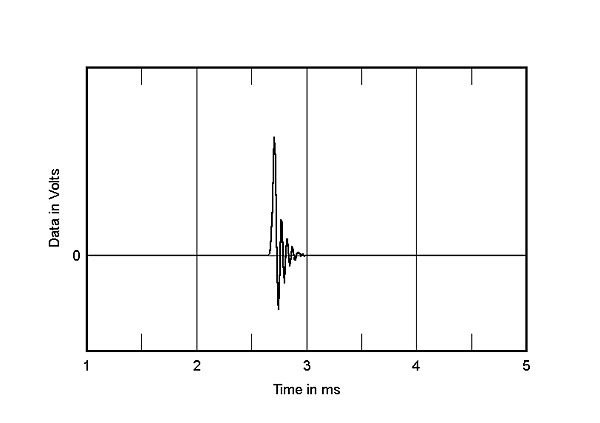
To highlight the differences between these filters in the frequency domain, I use a representation suggested to me by Jürgen Reis of MBL, in which the device under test decodes first 44.1kHz data representing white noise, then 44.1kHz data representing a full-scale tone at 19.1kHz. Fig.4, for example, shows the resulting spectrum with these signals with the Vega's Mode 1 filter. The white-noise spectrum reveals that the Vega's output rolls off rapidly above 21kHz; as a result, the sampling image of the 19.1kHz tone at 25kHz (blue and magenta traces) is completely suppressed. Note also the very low levels of the distortion components of the 19.1kHz tone in this graph. Filter Mode 2 is almost identical (not shown), but Mode 3 (fig.5) has a much slower rate of ultrasonic rolloff. Consequently, the 25kHz image of the high-level tone is reduced by just 24dB. Mode 4 offered another 6dB of image rejection (fig.6), but the still-slow rolloff correlated with the smaller amount of ringing in seen in fig.3.
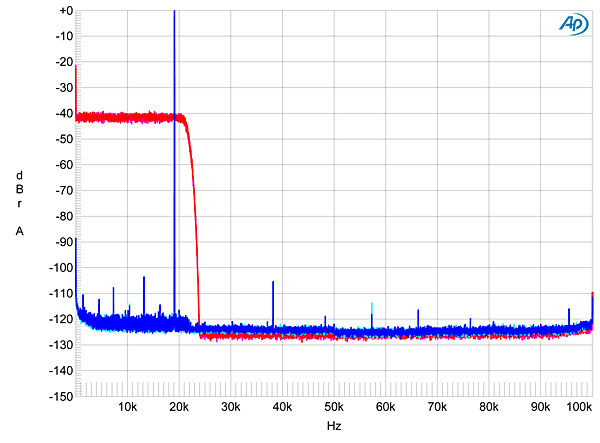

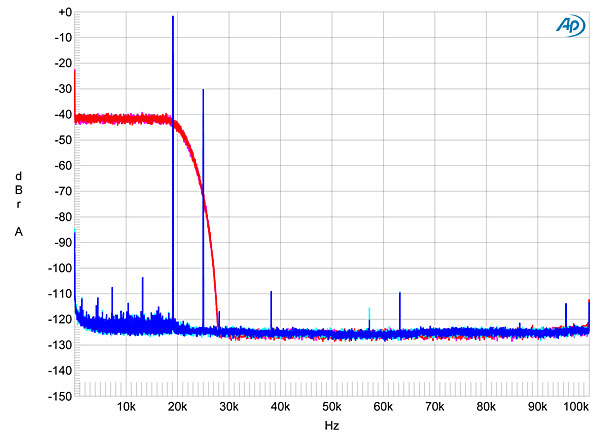
Fig.7 is a conventional frequency-response plot, taken with Filter Mode 1 and sample rates of 44.1, 96, and 384kHz. The channel levels match to within 0.05dB, and the shape of the response is the same with all three sample rates: flat almost to 20kHz, with then a gentle rolloff above the audioband broken by a sharp cutoff just below each of the three lower Nyquist frequencies (ie, half of each sample rate). With 384kHz data, the output was down by 16.5dB at 190kHz. Filter 2 was similar to Filter 1, though Filter 3 began to roll off above 16kHz with 44.1kHz data, reaching –3dB at 20kHz (not shwon). Filter 4 had the same premature rolloff above 16kHz with 44.1kHz data (fig.8, green and gray traces), but also rolled off earlier than Filter 1 with the higher sample rates. With 384kHz data, the output was down by 3dB at 85kHz and by 34.5dB at 140kHz.


Channel separation was superb, at >120dB in both directions below 4kHz (not shown). Fed dithered 16-bit data representing a 1kHz tone at –90dBFS via TosLink, the resultant spectrum of the Vega's output showed only the dither noise (fig.9, cyan and magenta traces). Increasing the bit depth to 24 (blue and red traces) dropped the noise floor by an astonishing 28dB, which suggests that the Vega's resolution is commendably close to 21 bits. Some spurious AC-supply components are visible in this graph, particularly in the left channel (blue trace), but as even the highest in level of these spuriae lies well below –130dB, these are inconsequential. When I repeated the test with 24-bit data via the Vega's USB port, I got the same spectrum, confirming that the processor handles 24-bit data via USB. Peculiarly, some very low-level, odd-order harmonics were visible in this spectrum (fig.10) that are absent from fig.9. Although these all lay at or below –146dB, I did wonder if they indicated some problem at the 24th-bit level with USB data. Again, however, these spuriae will be inconsequential.
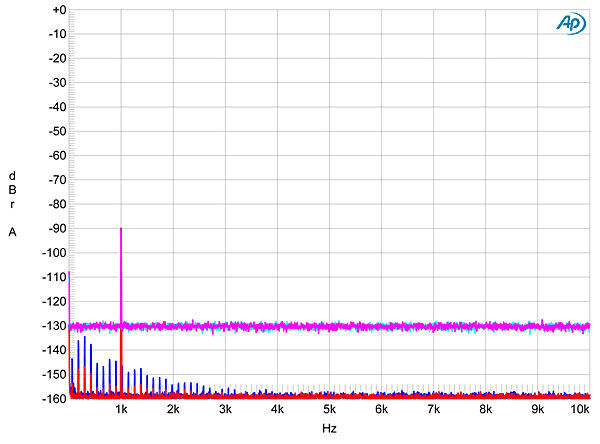
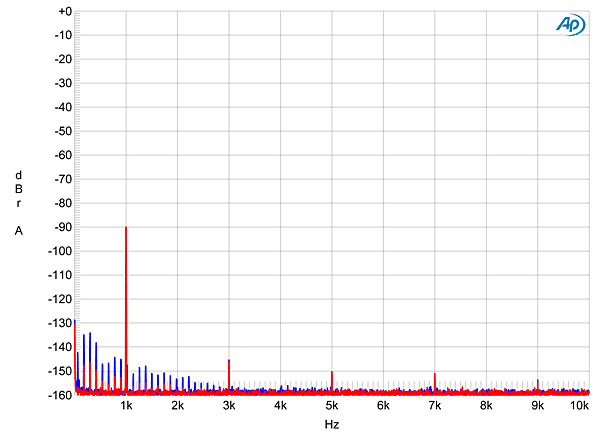
The spectral peaks at 1kHz in figs.9 & 10 kiss the –90dBFS line, suggesting that the DAC has minimal linearity error. In conjunction with the very low level of analog noise, this allowed the Vega's reproduction of an undithered sinewave at exactly –90.31dBFS (fig.11) to be perfect. The waveform is beautifully symmetrical about the time axis, and the three DC voltage levels defined by these data are superbly well resolved. I was using Filter Mode 4 for this measurement, and you can clearly see this filter's asymmetrical ringing on the waveform tops and bottoms; changing to Filter 1 gave the usual symmetrical Gibbs Phenomenon ringing (fig.12), while increasing the data's bit depth to 24 gave a well-defined sinewave, even at this very low level (fig.13).



Auralic's Vega offered very low levels of harmonic distortion, even when driving a full-scale signal into the very demanding 600 ohm load. Fig.14 reveals that the highest-level harmonic under those circumstances is the third, but that it lies at –116dB, or just 0.0002%! The Vega's performance with the high-frequency intermodulation test depended on the Filter mode used. With Mode 1 (fig.15), not only were the intermodulation products supremely well down in level, with the difference product at 1kHz lying at –128dB (0.00005%), all the ultrasonic images of the 19 and 20kHz tones are all very well suppressed. Mode 2 (not shown) was similar to Mode 1, but with Modes 3 and 4 (fig.16), the ultrasonic images were well evident. Even so, actual intermodulation was as low as it had been in fig.15.


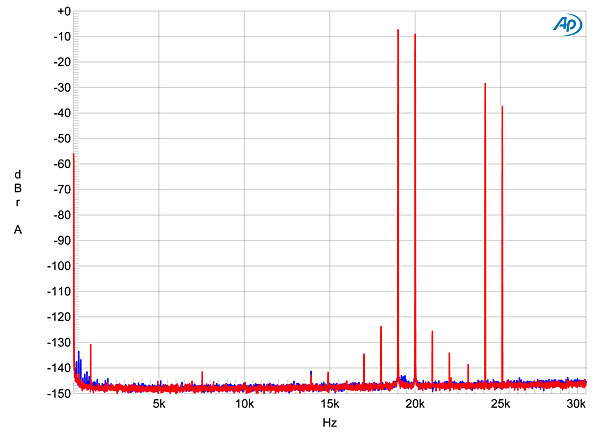
Tested for its rejection of word-clock jitter with the Femto Master Clock set to Auto, the Vega measured superbly well with all inputs, even TosLink. With 16-bit J-Test data (fig.17), all the odd-order harmonics of the low-frequency, LSB-level squarewave were at the correct level, and there were no jitter-related sidebands. With 24-bit data—fig.18 shows the output spectrum for data input to the USB port—the spectral spike that represents the 11.025kHz tone is virtually free from the spectral "shoulders" that would suggest the presence of low-frequency random jitter, and any sidebands lie at or below –144dB!
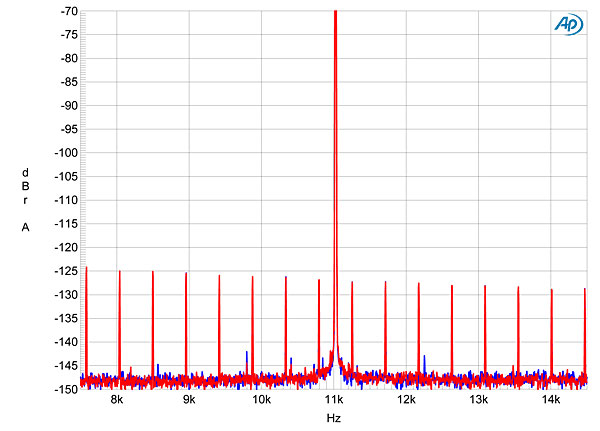

Auralic's Vega D/A processor offers measured performance that is beyond reproach.—John Atkinson

Because the maximum output voltage is the same for both the balanced and unbalanced outputs, does this mean the unit is not a balanced (differential) design?

Because the maximum output voltage is the same for both the balanced and unbalanced outputs, does this mean the unit is not a balanced (differential) design?
No, the balanced and unbalanced outputs are based on separate circuits, so I assume the fact that the output level from both are the same was a design decision. I rechecked and confirmed that both the hot and cold phases of the balanced output jacks are active.
John Atkinson
Editor, Stereophile

Dear Mr Atkinson,
Thanks for this nice review of the Vega.
How would you compare it with the Marantz NA11S1 you seemed to enjoy a lot ?
I would be interested to upgrade my PSAUDIO NuWave by one of those two DACs

Thanks for this nice review of the Vega.
You're welcome.
How would you compare it with the Marantz NA11S1 you seemed to enjoy a lot ?
Two very different products at the same price. The Auralic has the edge when it comes to ultimate sound quality - slightly better-defined lows, slightly better sense of space - but the Marantz has much more in the way of features. I could live with either.
One thing about the Auralic Vega that I noticed after my review was published is that with a very small number of recordings, there are occasional clicks with the volume control set to its maximum. These are recordings that, according to Pure Music's meters, have been mastered with many peaks reaching 0dBFS - what is happening is that the reconstructed analog signal waveform has occasional peaks between samples that are higher than the maximum recorded level, resulting in clipping.
Such recordings shouldn't exist becasue modern digital audio workstation programs have meters that reveal such inter-sample clipping. But not every mastering engineer is sufficiently careful.
The solution is easy: either reduce Pure Music's or the Vega's volume control by 1dB. Doing so doesn't affect sound quality.
John Atkinson
Editor, Stereophile

Thank you for posting this review early (1-2 months early). I was looking forward to this review but my February print issue never came.

Well, well, well! Within 2 days, JA and his main competitor TAS (with the Harley man, a former Stereophile protégé) both post a review of the same thingy!
http://www.theabsolutesound.com/articles/auralic-vega-digital-audio-processor-1/
A friendly game of "one upmanship"? Or, a battle to the death? Game on!
I bet it was the same review sample! That means the Harley man now has your fingerprints JA (I assume you reviewed it first).

Within 2 days, JA and his main competitor TAS (with the Harley man, a former Stereophile protégé) both post a review of the same thingy!
Coincidence. Plus the TAS review, by Chris Martens, was posted on February 12 and the Stereophile review was posted on January 31.
I bet it was the same review sample!
I know it wasn't. You'd lose the bet :-)
John Atkinson
Editor, Stereophile

Wow! Them guys have 2 review units! I am impressed. Yup, I would have lost that bet. I thought most audio or video companies had 1 review unit, and that reviewers had to wait until the other reviewer was finished...

Hi John, nice review of the Vega. Were your observations of the Vega primarily based on running the unit direct to your power amps (the Vega has digital attenuation) or with the Vega at full bore (ie, no attenuation of its output) through the line inputs of your analog preamp? In either case, balanced connections, I presume?

Is the Vega's connectivity to say an AMP dependent on matching the input sensitivity of the AMP and the Vega's output. Some say the Vega is "hot"
Output Voltage:
4Vrms at Max. with dynamic-loss-free digital volume
AMP in question is the JOb225:
INPUT SENSITIVITY
Nominal level : 0.75 V.
Unbalanced only (RCA).
51k input impedance.

Hi, I was surprised to learn from Auralic's brief on filter modes that in mode 4, for sample rates of 44.1k, the response is down 3 db at 20kHz. This is confirmed by JA's measurements. Yet, in some reviews, even at red book sample rate, mode 4 was preferred. While I realize much goes in to producing good sound quality, I thought one of the great (early) virtues of digital was flat frequency response. Any comments would be greatly appreciated.

Hey John. Thanks for this awesome reviews! I used to have the CP-800 and quite liked it although I wasn't a particular fan of the sterility it exhibited at times. How would you compare the CP-800 to the Vega? I'm all digital so a Dac with a pre function is what I'm after, and I'm hearing good things about the Vega.